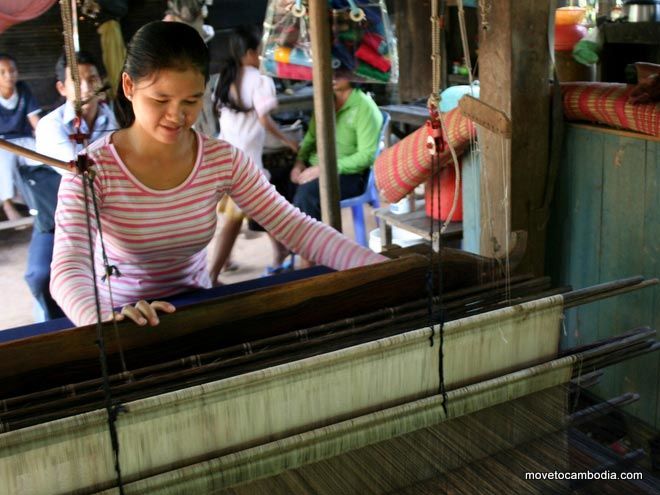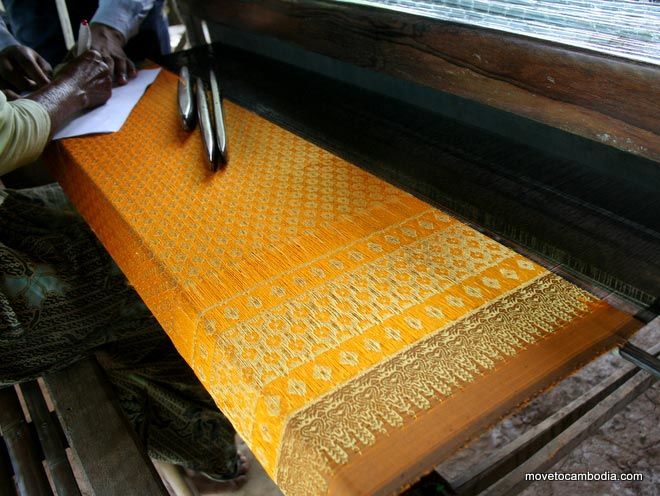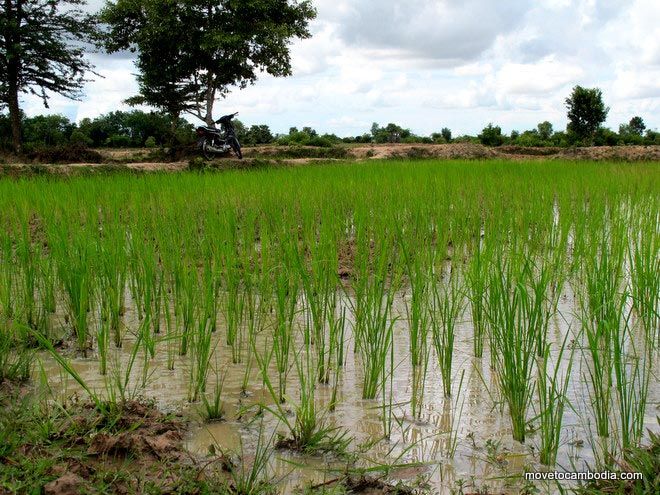Phnom Penh might not have the star draw of Angkor Wat to attract tourists, and the modest attractions of the Royal Palace, National Museum, and Khmer Rouge sites see only a fraction of the visitors that flood to Siem Reap. But a short trip to Koh Dach by bicycle, tuk-tuk or public bus offers a fantastic experience to witness rural Cambodia and avoid the city’s traffic and noise.

A young weaver at her family loom on Koh Dach.
Silk Island—Koh Dach in Khmer—gained its name from the island’s primary occupation, silk weaving. A decade ago nearly every household on this island in the middle of the Mekong had their own loom, but as the cost of silk production has increased, more and more of the island’s young weavers have left to look for work in nearby garment factories. Traditional weaving still takes place today, albeit on a more modest scale, and the sound of looms can still be heard as one travels along the narrow lanes that criss-cross the palm tree-dotted landscape.The easiest way to reach the island is on a $10-15 half-day tuk-tuk trip, easily arranged with the thousands of tuk-tuks loitering near tourist sites across Phnom Penh. For the more intrepid, it is easy to take bus route 6 to its northern terminus—1,500 riel—or cycle the 6-km north over the Japanese Bridge along National Road 6, and then pay less than 1,000 riel ($0.25) for the ferry.
Stepping off the ferry, visitors are likely to be greeted by ladies offering silk scarfs for sale, although it is better to travel further inland and visit the house of someone weaving themselves, or one of the tourist-focused silk-weaving centers.

Silk weaving is a traditional Cambodian art.
The centers show off the whole process involved in producing silk, from silkworms feasting on mulberry bush leaves (before being boiled to death), to spinning silk thread before being dyed, to the complex and fascinatingly complex designs the ladies produce on the wooden looms.
Aside from silk and cotton products, a visit to Silk Island is offers a fascinating glimpse of rural Cambodian life: Men and women wearing the traditional cotton krama as they go about their farming duties, water buffalo working the paddy fields, the splendor of Buddhist pagodas dotting the landscape, and a pace of life very different to the bustle of Phnom Penh.
The island’s rich agricultural heritage is visible everywhere you turn, with the verdant greens of rice plants competing with rows of corn as you move closer to the river banks.

A slice of rural Cambodian life.
There are a number of guesthouse options as well, for those wishing to extend their stay. Red House, near the ferry terminal, offers the chance to stay in a beautifully decorated traditional wooden house and sample authentic Cambodian food.
At the northern end of the island, French-owned La Kroma Villa offers a different experience, with spotless modern rooms and a view of the Mekong and a small swimming pool, while a wood-fired pizza oven brings some European options to the menu.
A new concrete road connects the ferry with the north of the island, heralding new development and making travel around the island more efficient and less dusty, if rather less adventurous. Bigger concrete houses are replacing older wooden ones, and rumors of a bridge to the mainland to replace the ferry has caused land prices to increase and demarcating walls have sprung up seemingly overnight. While this might affect the romantic image of bucolic Cambodia that makes the island attractive to tourists, these changes are bringing much sought-after improvements for residents who would understandably prefer to live with electricity and plumbing.
While Silk Island is certainly changing, it still holds enough of its former rustic charm to make it worth a visit from Phnom Penh…at least for now.
Thanks for the article, we had nice trip to the silk island. But the tuk tuk asking price is 25usd, we managed to get it to usd20, doesn’t seem likely to get it under 20usd. Also you need to pay 2usd for the round trip ferry. And Le Kroma Villa is at least 8km from the ferry or the tourism silk factory, so it might be a little far from people go there on bike. Le Kroma has nice pizza oven but we are told no pizza on weekdays, although we have seen more than 10 tuktuk taking people there for lunch. So the lunch options are quite limited. Just some information for people wants to take a half day trip there, but it’s still a nice way to spend time if you have enough time in Phnom Penh.